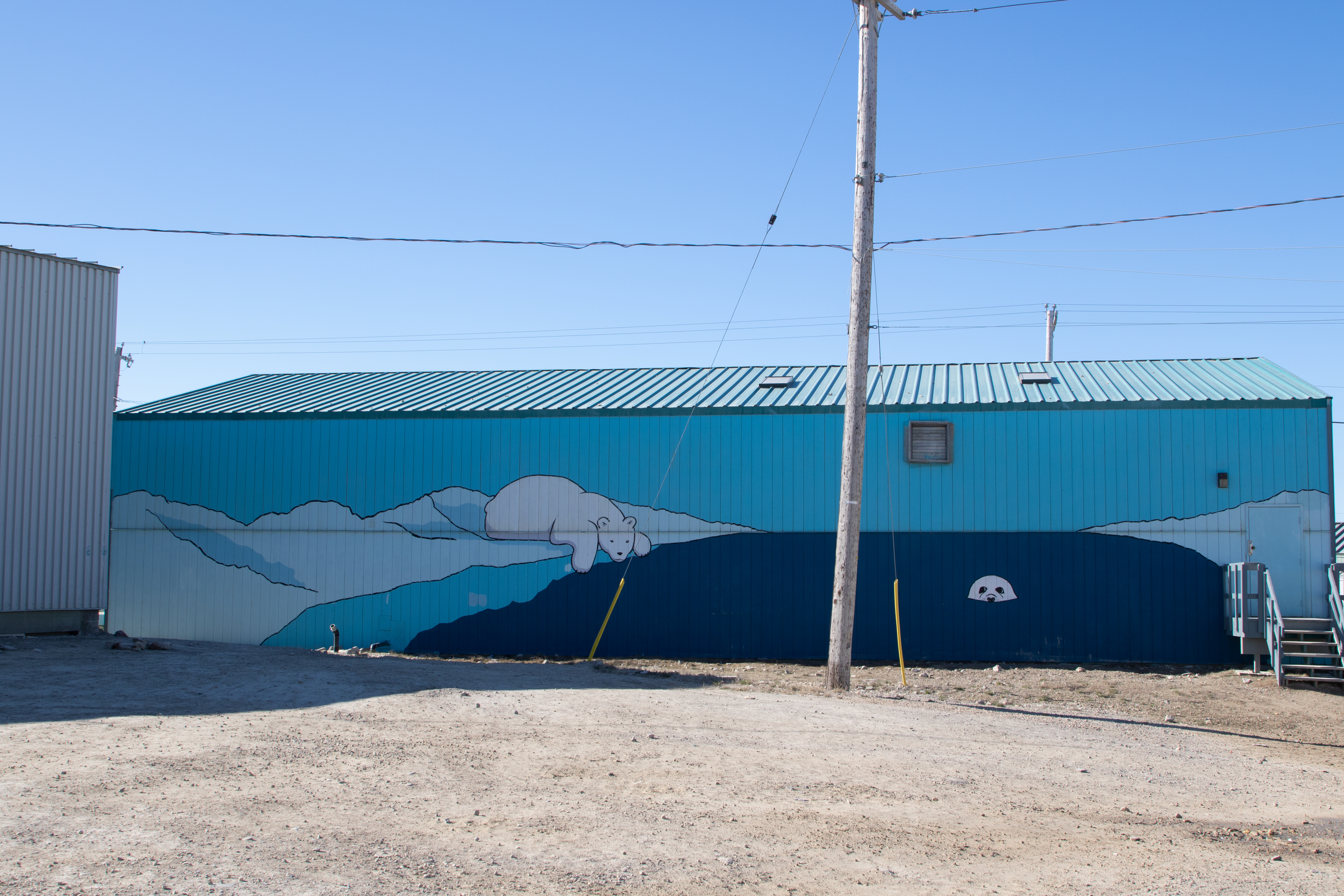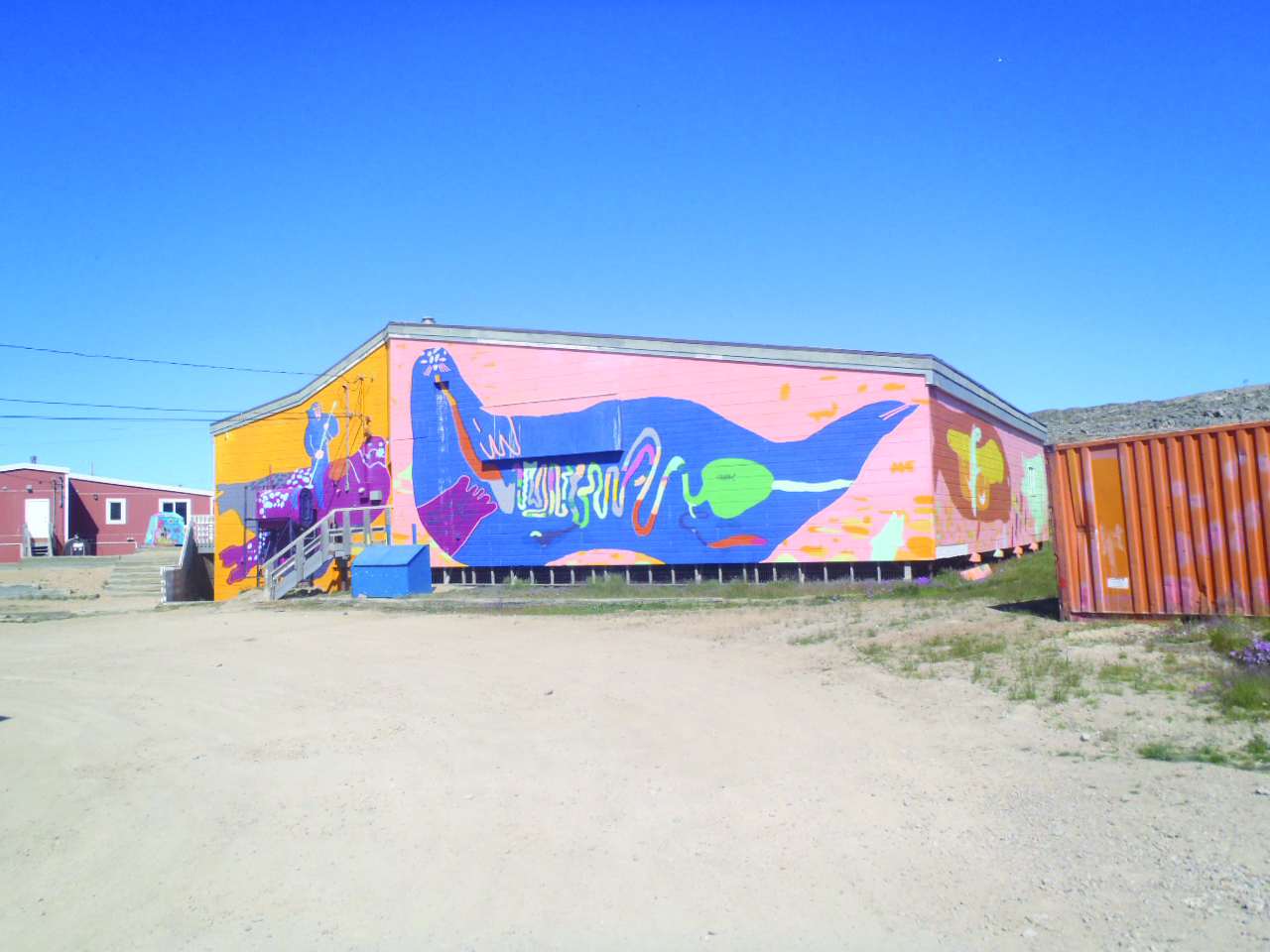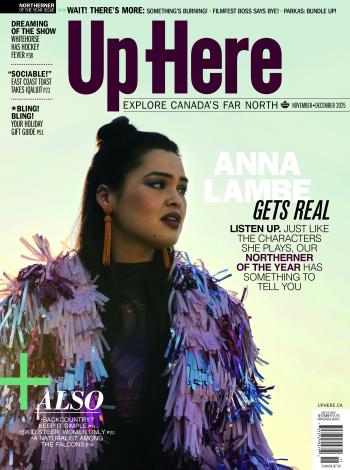Public works of art are like mirrors on a community. They can reflect the shared values of residents, as well as the people, places and traditions that locals hold important. Murals can memorialize community members who made outsized contributions in the past, or put a spotlight on those poised to be future leaders. They are visual reminders of vital lessons and traditional stories—or that better days always lay ahead. And they provide a venue for local artists to express themselves.
Here are the stories behind eight Northern murals that show the rest of the world what their communities hold dear.
TESLIN, YUKON

Keith Wolfe Smarch, a celebrated Yukon artist, has created dozens of works—from expressive wooden masks to vivid Tlingit paintings—over the last 40 years. When he was commissioned to brighten up the exterior of Teslin, Yukon’s George Johnston Museum (which honours the life of the Tlingit Elder and features exhibits that celebrate Tlingit culture and history), it became one of his biggest endeavours to date.
Selecting the appropriate colours was a major consideration for the mural, he says. “Red always represented life or blood and then the black was for protection,” Wolfe Smarch explains. “And then there's the blue, which came from copper oxide. And the Tlingit used it a lot—so much that now it's referred to as Tlingit blue.”
The Yukon artist spent two years planning out the design of the 42-foot-wide piece, creating a mural that represented his Tlingit culture and the values many Yukoners hold for the land. Painted in traditional Tlingit style, the shapes of people's faces make up the eyes of one massive human face. Below, the figure’s hands are open to represent a peace offering. Wolfe Smarch explains this reflects the idea that Tlingit would approach others with open hands, showing they carried no weapons.
The striking use of colour certainly attracts the public eye. Wolfe Smarch says the mural practically stopped traffic as he worked on it. “By the second day [of painting], people were constantly stopping by to look at it.”
YELLOWKNIFE, NWT

At the corner of 48th St. and 49th Ave. in Yellowknife, next to the Visual Effects framing store, hangs one of the city’s most striking murals. It was created in memory of the late Charlie Delorme, a street-involved resident from Yellowknife who passed away in 2013 at age 64, and stands as a strong testament to both his larger-than-life personality and the lasting impact he’s had on the community he called home.
“Charlie was just a lovely, wide-open kind of person,” says Terry Pamplin, an acquaintance of Delorme’s and the artist behind the mural. “He'd always ask you how you were doing, and it was nice to take five minutes and relate to somebody else in the world.”
Despite not having much himself, Delorme was exceedingly generous, donating large chunks of his federal residential school compensation to local organizations such as SideDoor, a program for at-risk youth.
Pamplin eagerly accepted the task of painting the mural to commemorate Delorme when asked in 2017. He knew there was no one more deserving of the tribute. Using two photographs of Delorme for reference, he overlaid painted portraits on a map of Yellowknife and N'dilǫ (Delorme’s “old stomping grounds,” Pamplin explains).
“To reach back and reinvigorate that connection to a person [who’s passed away] can become…well, very personal and somewhat emotional,” says Pamplin.
When the mural was officially unveiled in April 2018, it drew a crowd of Yellowknifers, including many of Delorme’s friends and family, some of whom shared a few words—and complimented the artwork. “Everybody just loved it.”
CAMBRIDGE BAY, NUNAVUT

It's nearly impossible to walk by the indoor swimming pool in Cambridge Bay (Ikaluktutiak) and not crack a smile. The building’s exterior has been transformed into a fantastical homage to creatures of the floe edge, a place vital for sustenance and culture for the community. On one side, a smiling polar bear lies in wait for a shy seal peeking through the sea ice; on another, a sunglasses-wearing walrus lifts a flipper to greet passersby.
Zoe Ohokannoak, a local artist currently studying at the Nova Scotia School of Art and Design, is one of the visionaries behind these cheery scenes. Though no stranger to painting murals (both Cambridge Bay’s high school and wellness centre display some of Ohokannoak’s work), the pool was his biggest undertaking to date.
“It was ridiculously huge,” Ohokannoak says. “There were a lot of days where our arms were just sore, especially painting the bigger areas.”
Despite the aches and pains, the mural project has added some colour and brightness to Cambridge Bay’s downtown core. Ohokannoak and mural partner Sam Siberia took to their mission with zeal after getting the go-ahead from hamlet administration in 2019. The two even invited kids from the local daycare program to help paint the blue ocean base-coat in the summer.
“They definitely enjoyed it for the first part. Then, as things went on, they got more tired…and would try to sneak and paint themselves,” Ohokannoak says, with a chuckle. “But it was a great opportunity to give back to the community and involve other youth in the process.”
MAYO, YUKON

Avant-garde and abstract in their design, the faces gracing Mayo’s grocery store almost look like the work of Pablo Picasso. But don’t be fooled: they’re actually spray-painted self-portraits of 11 different high-schoolers in the community.
The artwork was a collaboration between Ottawa’s Carleton University, the local Na-Cho Nyak Dun First Nation, and the Yukon First Nation Education Directorate’s mobile therapeutic unit, and spurred by the unshakeable belief that art can foster wellness.
In fact, Jeremy Parkin, a support worker with the mobile therapeutic unit, says mural projects are one of the most effective ways to do this. “It’s the level of community engagement that you get, since it’s largely a team effort,” he says. “And with it being something that's public-facing, there's a lot of pride attached and a lot of confidence in putting something up that is going to be in the town you live in for the foreseeable future.”
Graduate students from Carleton began virtually meeting with the students in Mayo in January 2021 to design their self-portraits. These designs were later projected onto the grocery store wall that summer and, for five days, the students, mobile therapeutic unit team, and other Mayo residents worked together to fill in colours and bring the murals to life. They capped it all off with a community barbecue.
“The community was excited,” Parkin recalls. “There was a ton of work and energy put into it…and to be able to celebrate the art that the students accomplished was amazing.”
INUVIK, NWT

To Dez Loreen, the Inuvik Northmart was just another corrugated metal building that he never gave much thought to. But after its transformation in 2018, he feels proud whenever he passes it.
The comedian and performing artist’s daughter, Paige, was about 10 years old when she and 19 other young Inuvik residents created a mural to decorate the prominent wall on Inuvik’s main drag. In anticipation of Inuvik’s 60th anniversary, the town received a $10,000 grant from the NWT Arts Council. Artist Patrick Thompson, known best as co-founder of Embassy of Imagination, flew up from Toronto to provide mentorship to the group. Participants created 60 different northern animals and objects that now hang on the supermarket’s yellow wall: Loreen says Paige helped cut out and paint a moose and a snowmobile.
“She was really proud when we saw the actual finished product go up because she was able to show us the pieces that she had contributed to,” Loreen says, adding his daughter comes from a family of artists and she appreciated the opportunity to express herself.
Loreen takes joy in seeing the way murals have brightened up his community, showing just how creative Inuvik’s residents are. “It’s one of the many pieces we have in town, so it’s part of a bigger picture,” he says.
WHITEHORSE, YUKON

When Nathalie Parenteau found out her mural design was among several chosen to grace public buildings around Whitehorse, she was thrilled. Then she heard hers would be installed on the side of the Takhini Arena, and that excitement quickly turned to shock. The painter imagined her piece might be something small—inside city hall maybe—not the massive 22-panel, 64-by-12-foot behemoth hanging outside today. “I’m a simple country girl,” Parenteau, originally from Québec, jokes.
But she’s not one to shy away from a challenge, so Parenteau rolled up her sleeves and set to work sketching, stenciling, and painting. In all, it took about four months to finish the piece—with Parenteau and her partner Peter von Gaza working nearly full-time.
Titled ‘Rhythms of a Northern Town,’ the mural gives onlookers a smattering of what makes Whitehorse special. A woman paddles a canoe down the rushing Yukon River, with moose, caribou, salmon and coyotes incorporated into the water and landscapes. A paddle-wheeler chugs along in the background. And, of course, both the midnight sun and northern lights are accounted for.
“These are all things that people are moved and comforted by,” Parenteau says. “I hope that everyone living here can find something to identify with.” The mural, created with enamel paint on aluminum panels, was officially installed on the arena last October and has since become one of the city’s most beloved works of public art.
And it should last for many years to come. As Parenteau says, “It’s a little echo of my time in Whitehorse during my lifetime. I feel pretty happy that this is what I will leave behind.”
NDILO, NWT

An Elder walks toward a teepee, carrying a basket of food. Beneath the ground, Mother Earth cradles a baby growing inside her stomach. Above, happy faces in clouds smile down at the scene.
“The mural is meant to communicate what it is to have healthy babies and youth, and what it is to raise them in the North,” says Carla Rae Taylor, a Yellowknife artist, who helped with the planning stages of the mural.
Taylor was one of 21 artists involved with the Strong People, Strong Communities murals project, devoted to creating public art across Yellowknife, Dettah and Ndilǫ in 2021. The project has resulted in six murals, designed and painted by different local groups—youth, Elders, the LGBTQ+ community—to express what it means to have a strong community.
The scene on the mural in Ndilǫ came together after local youth were asked what strong communities meant to them. “If you look at the painting, there are faces in the clouds, and that’s to represent and honour the ancestors. And at the bottom is the image of a woman with a child in her tummy and she’s Mother Earth. There’s a new sprout growing out of the Earth. So it's this idea of having a strong connection to Mother Earth in order to raise the next generation.”
Sisters Mahalia Yakeleya Newmark and Kalina Newmark, from the NWT, led the project, putting out a call to community members and nationally, to Indigenous artists, asking them to participate in the project and share their ideas. This ensured the murals highlighted Indigenous stories. It’s that community effort that makes the project all the more special, says Yakeleya Newmark. “It’s heartwarming,” she says. “It was a community of people who stepped forward and wanted to be a part of this.”
KINNGAIT, NUNAVUT

On a winter day in Kinngait, it can feel like the dark skies will be there forever. But the walls of the community hall serve as a reminder that the sunny days of spring—and the warmth that comes with them—are never that far away.
That was the idea Kinngait youth had in mind while creating the vibrantly coloured mural back in 2017. Toronto-based Embassy of Imagination led the project, landing in the Nunavut community to work with local youth and mentor artists like Cie Taqiasuk and Parr Josephee. Over two months, Alexa Hatanaka and Patrick Thompson, founders of the arts initiative, hosted drawing workshops, storytelling sessions with Elders, and games where kids could draw their own designs on a piece of paper and then add on to each other’s drawings. “We [treat] each project as a fun, easily achievable and whimsical experience,” says Thompson.
The exercises and excursions inspired the creative and collaborative scene displayed on the community hall today. One side of the building features an image of a seal, with many of its organs painted in colourful shapes and swirls. To Thompson, the mural represents “enormous, joyful records of a time and a place when a group of people got together to have fun and work together.”










